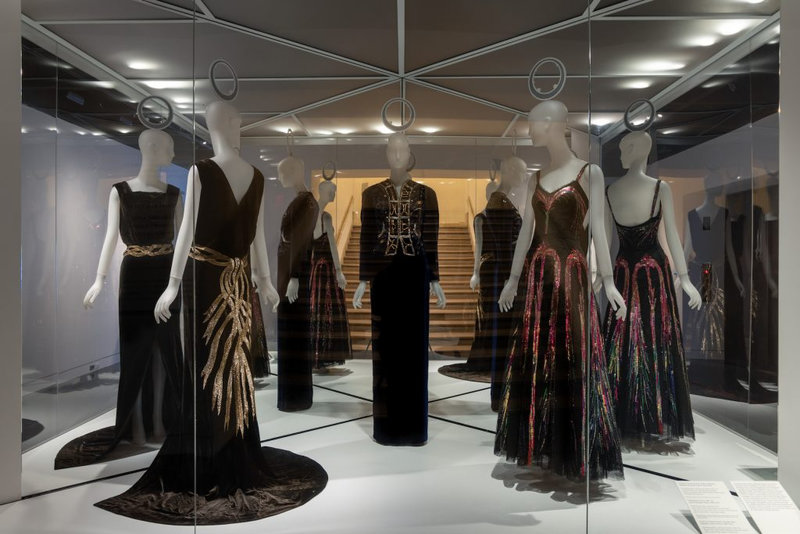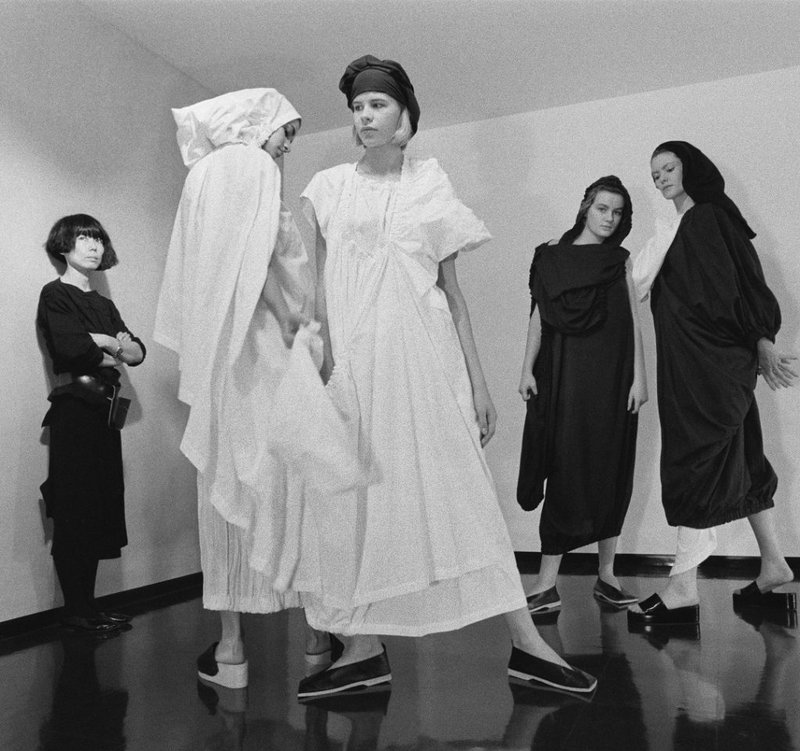Met’s Fall 2023 Exhibition to Celebrate the Creativity and Artistic Legacy of Women Designers and Women-Led Fashion Houses
Claire McCardell wearing her “Future dress,” 1945. Photo by Erwin Blumenfeld. Photo © The Estate of Erwin Blumenfeld 2023
NEW YORK - The Costume Institute’s fall 2023 exhibition, Women Dressing Women, will celebrate the creativity and artistic legacy of women designers. On view at The Met Fifth Avenue from December 7, 2023 through March 3, 2024, the show will feature designers whose fashions are represented in the Museum’s permanent collection.
Comprising approximately 80 objects that document the work of more than 70 makers, the exhibition will trace a lineage of influential women-led fashion houses from the 20th century to the present, highlighting the pioneering designers who led them. Designers whose work will be on view include Rei Kawakubo for Comme des Garçons, Adèle Henriette Nigrin Fortuny, Gabriela Hearst, Ann Lowe, Claire McCardell, Pia Davis and Autumn Randolph for No Sesso, Miuccia Prada, Madeleine Vionnet, and Vivienne Westwood, among many others.
Through the exploration of four key notions—anonymity, visibility, agency, and absence/omission—Women Dressing Women will offer a new interpretation of the traditional canon of fashion history and examine the ways in which the industry has served as a powerful vehicle for women’s social, financial, and creative autonomy. Discoveries about the identities, mentorship histories, and connections between women makers throughout history will be explored, providing new insights and an enhanced understanding of their work.
The exhibition and catalogue are made possible by Morgan Stanley.
Claire McCardell wearing her “Future dress,” 1945. Photo by Erwin Blumenfeld. Image courtesy of The Metropolitan Museum of Art. Photo © The Estate of Erwin Blumenfeld 2023
Max Hollein, The Met’s Marina Kellen French Director and CEO, said: “This timely exhibition will invite visitors to reflect on the vital contributions of women to fashion from the early 20th century to the present through The Costume Institute’s incomparable collection. Women Dressing Women will also continue the Museum’s dedication to amplifying historically underappreciated voices while celebrating the work of those who have become household names. The spectacular garments on view will inspire a renewed appreciation for the multidisciplinary talents at the heart of this vibrant art form and for the countless women whose contributions were, and continue to be, the lifeblood of the global fashion industry we see today.”
Andrew Bolton, Wendy Yu Curator in Charge, The Costume Institute, added: “Women have been instrumental to the success of The Costume Institute since its inception—its founding members include several inspiring women—and the department remains dedicated to recognizing the artistic, technical, and social achievements of women. We look forward to this opportunity to honor many of the designers, donors, and scholars who have contributed to shaping The Costume Institute and, more broadly, the history of fashion.”
Mellissa Huber, Associate Curator, The Costume Institute, added: “Our fall exhibition will provide an opportunity to engage with the critical histories of innovative women designers, all of whom played pivotal roles in the conception of fashion as we know it today. In recognizing that the contributions of women to fashion are unquantifiable, our intention with this show is to celebrate and acknowledge through a focus on The Costume Institute’s permanent collection, which represents a rich timeline of Western fashion history. We hope that this exhibition will foster impactful conversations between our visitors and across the designers’ larger bodies of work, highlighting the plurality and diversity of women’s important contributions to the field.”
Karen Van Godtsenhoven, guest co-curator of the exhibition, commented: “The connective thread between different generations of professional women reveals how subsequent generations have built and expanded upon the legacy of their predecessors. By reflecting on the intergenerational dialogues between these designers and the talented women who worked alongside them, we aim to offer a contemporary point of view, further propelling the conversation between audiences and scholars.”
Gallery view, “Agency: Liminal Spaces of Fashion.” “Theodosia” tea gown by Maria Monaci Gallenga, ca. 1925. Photo: © The Metropolitan Museum of Art.
Exhibition Overview
Women Dressing Women will explore the work of both widely celebrated and lesser-known women designers and women-led fashion houses from the 20th century to the present, surfacing a series of intergenerational conversations that underscore ideas related to women’s social progress as charted through fashion. The exhibition will uncover new information about understudied designers and houses that were influential during their activity, expanding upon the canon of Western fashion by highlighting rare works from The Costume Institute’s collection, some of which will be on view at The Met for the first time.
The exhibition will open by considering the condition of anonymity beginning with the role of the anonymous dressmaker as a type of collective ancestor leading to the present-day eponymous designer.
The Carl and Iris Barrel Apfel Gallery will introduce a pantheon of women designers who worked in Paris, the historical center of the stratified haute couture industry, displaying an area of strength in The Costume Institute’s early 20th-century collection. Through highlighting notions of visibility, the rise of the couturier, and the collective nature of design, this section will examine the ways in which fashion served as a vehicle to provide early forms of financial, social, and creative autonomy for women.
The Lizzie and Jonathan Tisch Gallery will expand the lineage of female designers across time and geography, using the premise of agency to reveal how generational shifts led to new opportunities for women. Objects and makers represented in this section will demonstrate different entry points to the fashion industry through adjacent areas of the arts and the cultivation of autonomous environments with the rise of independent shops and boutique culture. Garments by contemporary designers working from the 1960s to the present will emphasize the ways in which fashion has served as a site of political and bodily expression, engaging with notions of identity and choice.
The exhibition will close by highlighting stories of absence or omission through the presentation of objects by designers whose work has only recently begun to receive widespread credit and recognition, such as Ann Lowe, who designed Jacqueline Bouvier’s wedding dress for her marriage to then-Senator John F. Kennedy in 1953, and Adèle Henriette Nigrin Fortuny, who was instrumental in the design of the famed “Delphos” gown, first introduced in 1909.
Iconic pieces by well-known designers will be on display, including garments by Sarah Burton, Gabrielle Chanel, Ann Demeulemeester, Elizabeth Hawes, and Jeanne Lanvin. Pieces representing designers who have maintained a significant presence in The Costume Institute’s collection and exhibition history—such as Germaine Émilie Krebs, who created under the names Alix and Mme. Grès; Miuccia Prada; and Elsa Schiaparelli—will also be featured.
Examples by contemporary designers, including Hillary Taymour for Collina Strada, Anifa Mveumba for Hanifa, Iris Van Herpen, Norma Kamali, Ester Manas, Jamie Okuma, Simone Rocha, Marine Serre, Yeohlee Teng, and Isabel Toledo, among others, will illustrate the creative and conceptual possibilities of contemporary design, highlighting inclusive definitions of womanhood, collaborative practices, a sustainable mindset, and the plurality that has come to define the spirit of fashion today.
Designers whose work will be on view are as follows: Adèle Henriette Elisabeth Nigrin Fortuny, Mariano Fortuny (Fortuny); Ana de Pombo (House of Paquin); Ann Demeulemeester; Ann Lowe; Anifa Mvuemba (Hanifa); Augusta Bernard (Augustabernard); Autumn Randolph, Pia Davis (No Sesso); Barbara Hulanicki (BIBA); Betsey Johnson; Bonnie Cashin; Claire McCardell; Charlotte Larrazet (Premet); Diane von Furstenberg; Donna Karan; Elizabeth Hawes; Elsa Schiaparelli; Ester Manas, Balthazar Delepierre (Ester Manas); Gabrielle Chanel (Chanel); Gabriela Hearst x Gees Bend Quilters (Chloé); Georgina Godley; Germaine Émilie Krebs (Alix, Madame Grès); Grace Wales Bonner, Maria Grazia Chiuri (Dior); Hanae Mori; Hillary Taymour (Collina Strada); Iris van Herpen; Isabel Toledo; Jamie Okuma; Jean Muir; Jeanne d'Etreillis, Sylvie Boué de Montegut (Boué Soeurs); Jeanne Lanvin (Lanvin); Jeanne Victorine Margaine-Lacroix (Margaine-Lacroix); Jasmine Søe (Customiety); Jessie Franklin Turner; Jil Sander; Kate Mulleavy, Laura Mulleavy (Rodarte); Katharine Hamnett; Lucy Christiana Duff-Gordon (Lucile); Madame Havet (Agnès-Drecoll); Madeleine Lepeyre, Madame Madeleine (Madeleine & Madeleine); Madeleine Maltezos, Suzie Carpentier (Mad Carpentier); Madeleine Vionnet (Vionnet); Maggy Besançon de Wagner (Maggy Rouff); Marcelle Chaumont; Maria Grazia Chiuri (Dior); Marie Angenard (Jeanne Hallée); Marie Callot Gerber (Callot Soeurs); Marie Cuttoli (Myrbor); Marie-Louise Boulanger (Louiseboulanger); Marie-Louise Bruyère (Bruyère); Maria Monaci Gallenga (Gallenga); Marine Serre; Mariska Karasz; Melitta Baumeister; Miuccia Prada (Prada); Nina Ricci (Ricci); Norma Kamali; Pauline (Potter) de Rothschild (Hattie Carnegie); Pauline Trigère; Phoebe Philo (Celine); Rei Kawakubo (Comme des Garçons); Sarah Burton (Alexander McQueen); Sarah Lipska; Simone Rocha; Sonia Levienne Colefax (Chez Sonia); Sonia Rykiel; Tina Leser; Tory Burch; Valentina; Vera Maxwell; Vivienne Tam; Vivienne Westwood; Yeohlee Teng; Zandra Rhodes.
Gallery view: Left, Evening dress by Madeleine Vionnet, 1924-25; center: Evening jacket, Elsa Schiaparelli, 1937; right: Evening dress, Gabrielle Chanel, 1928-39. Photo: © The Metropolitan Museum of Art.
Gallery View, “Agency: Appropriating Menswear.” Photo: © The Metropolitan Museum of Art.
Gallery view, “Agency.” Left: Evening dress by Pauline de Rothschild for Hattie Carnegie Inc.; center “Future dress” Claire McCardell, 1945; right: tea gown, Jessie Franklin Turner ca. 1928. Photo: © The Metropolitan Museum of Art.
Gallery view, “Absence | Omission.” Left: Dress by Ester Manas and Balthazaar Delpierre for Ester Manas 2022. Right: “Delphos” gown, Adèle Henriette Elisabeth Nigrin Fortuny and Mariano Fortuny for Fortuny ca. 1932. Photo: © The Metropolitan Museum of Art?
Rei Kawakubo with models wearing Comme des Garçons, published in People, December 26, 1983. Photo by Takeyoshi Tanuma. Image courtesy of The Metropolitan Museum of Art.

/https%3A%2F%2Fprofilepics.canalblog.com%2Fprofilepics%2F1%2F0%2F100183.jpg)
/https%3A%2F%2Fstorage.canalblog.com%2F03%2F02%2F119589%2F96711876_o.jpg)
/https%3A%2F%2Fstorage.canalblog.com%2F11%2F31%2F119589%2F94773502_o.jpg)
/https%3A%2F%2Fstorage.canalblog.com%2F20%2F83%2F119589%2F94772815_o.jpg)
/https%3A%2F%2Fstorage.canalblog.com%2F26%2F72%2F119589%2F75604929_o.jpg)
/https%3A%2F%2Fstorage.canalblog.com%2F59%2F60%2F119589%2F26458628_o.jpg)










/http%3A%2F%2Fstorage.canalblog.com%2F95%2F26%2F119589%2F115765112_o.jpg)
/http%3A%2F%2Fstorage.canalblog.com%2F07%2F33%2F119589%2F31902497_o.jpg)
/http%3A%2F%2Fstorage.canalblog.com%2F13%2F71%2F119589%2F31158003_o.jpg)
/http%3A%2F%2Fstorage.canalblog.com%2F82%2F95%2F119589%2F30765887_o.jpg)